胡壮麟 第十章 语言学教程ppt课件
- 格式:ppt
- 大小:1.28 MB
- 文档页数:37

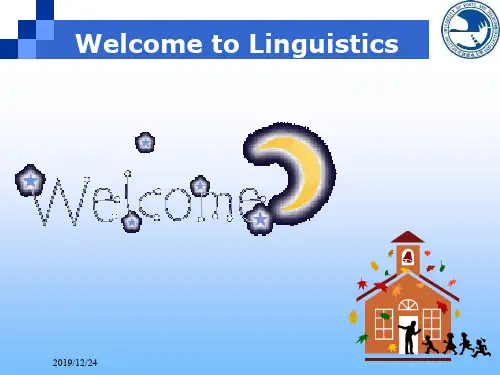
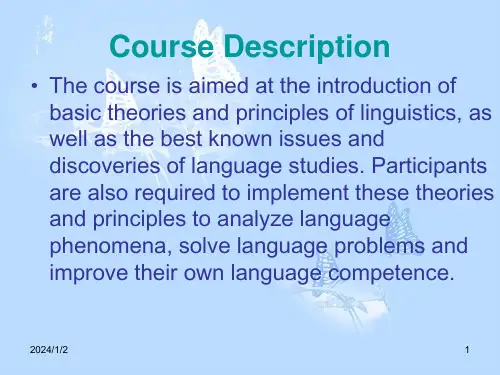
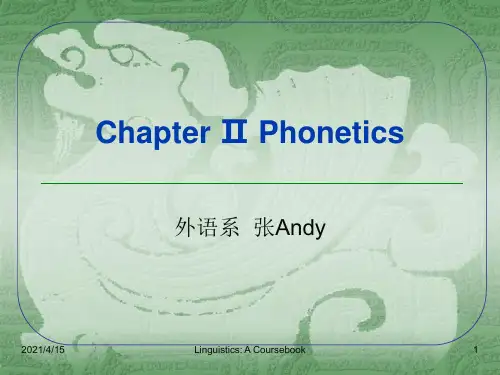
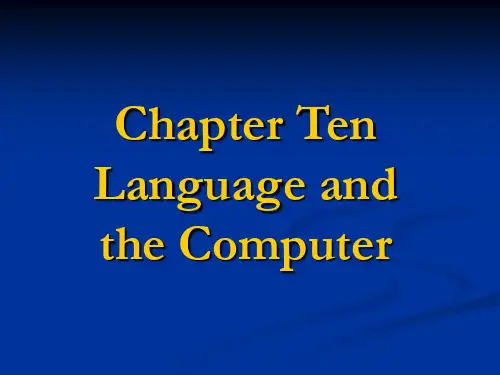

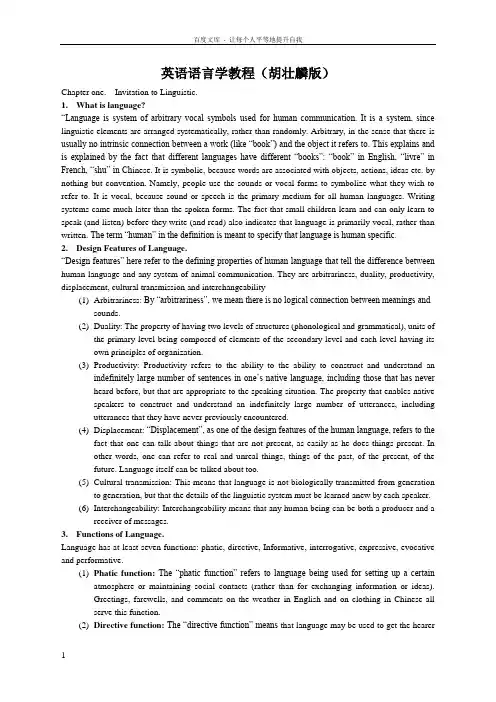
英语语言学教程(胡壮麟版)Chapter one. Invitation to Linguistic.1.What is language?“Language is system of arbitrary vocal symbols used for human communication. It is a system, since linguistic elements are arranged systematically, rather than randomly. Arbitrary, in the sense that there is usually no intrinsic connection between a work (like “book”) and the object it refers to. This explains and is explained by the fact that different languages have different “books”: “book” in English, “livre” in French, “shu” in Ch inese. It is symbolic, because words are associated with objects, actions, ideas etc. by nothing but convention. Namely, people use the sounds or vocal forms to symbolize what they wish to refer to. It is vocal, because sound or speech is the primary medium for all human languages. Writing systems came much later than the spoken forms. The fact that small children learn and can only learn to speak (and listen) before they write (and read) also indicates that language is primarily vocal, rather than written. The term “human” in the definition is meant to specify that language is human specific.2.Design Features of Language.“Design features” here refer to the defining properties of human language that tell the difference between human language and any system of animal communication. They are arbitrariness, duality, productivity, displacement, cultural transmission and interchangeability(1)Arbitrariness: By “arbitrariness”, we mean there is no logical connection between meanings andsounds.(2)Duality: The property of having two levels of structures (phonological and grammatical), units ofthe primary level being composed of elements of the secondary level and each level having its own principles of organization.(3)Productivity: Productivity refers to the ability to the ability to construct and understand anindefinitely large number of sentences in one’s native language, including those that has never heard before, but that are appropriate to the speaking situation. The property that enables native speakers to construct and understand an indefinitely large number of utterances, including utterances that they have never previously encountered.(4)Displacement: “Displacement”, as one of the design features of the human language, refers to thefact that one can talk about things that are not present, as easily as he does things present. In other words, one can refer to real and unreal things, things of the past, of the present, of the future. Language itself can be talked about too.(5)Cultural transmission: This means that language is not biologically transmitted from generationto generation, but that the details of the linguistic system must be learned anew by each speaker.(6)Interchangeability: Interchangeability means that any human being can be both a producer and areceiver of messages.3.Functions of Language.Language has at least seven functions: phatic, directive, Informative, interrogative, expressive, evocative and performative.(1)Phatic function: The “phatic function” refers to language being used for setting up a certainatmosphere or maintaining social contacts (rather than for exchanging information or ideas).Greetings, farewells, and comments on the weather in English and on clothing in Chinese all serve this function.(2)Directive function: The “directive function” means that language may be used to get the hearerto do something. Most imperative sentences perform this function, e. g., “Tell me the result when you finish.”(3)Informative function: Language serves an “informational function” when used to tellsomething, characterized by the use of declarative sentences. Informative statements are often labeled as true (truth) or false (falsehood).(4)Interrogative function: When language is used to obtain information, it serves an “interrogativefunction”. This includes all questi ons that expect replies, statements, imperatives etc.(5)Expressive function: The “expressive function” is the use of language to reveal somethingabout the feelings or attitudes of the speaker.(6)Evocative function: The “evocative function” is the use of langu age to create certain feelings inthe hearer. Its aim is, for example, to amuse, startle, antagonize, soothe, worry or please.(7)Per formative function: This means people speak to “do things” or perform actions.4. What is linguistic?“Linguistics” is the sc ientific study of language. It studies not just one language of any one society, but the language of all human beings. In short, linguistics studies the general principles whereupon all human languages are constructed and operate as systems of communication in their societies or communities. 5. Main branches of linguistics.The study of language as a whole is often called general linguistics. But a linguist sometimes is able to deal with only one aspect of language at a time, thus the arise of various branches: phonetics, phonology, morphology, syntax, semantics, pragmatics, sociolinguistics, applied linguistics, psycholinguistics etc. 6. Important distinctions in linguistic.(1) synchronic study vs. diachronic studyThe description of a language at some point of time (as if it stopped developing) is a synchrony study (synchrony). The description of a language as it changes through time is a diachronic study (diachronic).(2) Speech vs. writingSpeech is primary, because it existed long before writing systems came into being. Genetically children learn to speak before learning to write. Secondly, written forms just represent in this way or that the speech sounds: individual sounds, as in English and French as in Japanese. In contrast to speech, spoken form of language, writing as written codes, gives language new scope and use that speech does not have. Most modern linguistic analysis is focused on speech, different from grammarians of the last century and theretofore.(3) Descriptive vs. prescriptiveA linguis tic study is “descriptive” if it only describes and analyses the facts of language, and “prescriptive” if it tries to lay down rules for “correct” language behavior. Linguistic studies before this century were largely prescriptive because many early grammars were largely prescriptive because many early grammars were based on “high” (literary or religious) written records. Modern linguistics is mostly descriptive.(4). langue vs. paroleF. de Saussure refers “langue” to the abstract linguistic system shared by all the members of a speech community and refers “parole” to the actual or actualized language, or the realization of langue. Langue is abstract, parole specific to the speaking situation; langue not actually spoken by an individual, parole always a naturally occurring event; langue relatively stable and systematic, parole is a mass of confused facts, thus not suitable for systematic investigation. What a linguist ought to do, according to Saussure, is to abstract langue from instances of parole, . to discover the regularities governing all instances of paroleand make than the subject of linguistics. The langue-parole distinction is of great importance, which casts great influence on later linguists.(5). competence vs. performanceAccording to N. Choms ky, “competence” is the ideal language user’s knowledge of the rules of his language, and “performance” is the actual realization of this knowledge in utterances. The former enables a speaker to produce and understand an indefinite number of sentences and to recognize grammatical mistakes and ambiguities. A speaker’s competence is stable while his performance is often influenced by psychological and social factors. So a speaker’s performance does not always match or equal his supposed competence. Chomsky believes that linguists ought to study competence, rather than performance. (6). linguistic potential vs. linguistic behaviorThese two terms, or the potential-behavior distinction, were made by M. A. K. Halliday in the 1960s, from a functional point of view. There is a wide range of things a speaker can do in his culture, and similarly there are many things he can say, for example, to many people, on many topics. What he actually says . his “actual linguistic behavior”) on a certain occasion to a certain per son is what he has chosen from many possible injustice items, each of which he could have said (linguistic potential).Chapter 2 Phoneticsis phonetics?“Phonetics” is the science which studies the characteristics of human sound-making, especially those sounds used in speech, and provides methods for their description, classification and transcription, speech sounds may be studied in different ways, thus by three different branches of phonetics.(1) Articulatory phonetics; the branch of phonetics that examines the way in which a speech sound is produced to discover which vocal organs are involved and how they coordinate in the process.(2) Auditory phonetics, the branch of phonetic research from the hearer’s point of view, looking into the impression which a speech sound makes on the hearer as mediated by the ear, the auditory nerve and the brain.(3) Acoustic phonetics: the study of the physical properties of speech sounds, as transmitted between mouth and ear. Most phoneticians, however, are interested in articulatory phonetics.2. The IPAThe IPA, abbreviation of “International Phonetic Alphabet”, is a compromise system making use of symbols of all sources, including diacritics indicating length, stress and intonation, indicating phonetic variation. Ever since it was developed in 1888, IPA has undergone a number of revisions.3. Place of articulationIt refers to the place in the mouth where, for example, the obstruction occurs, resulting in the utterance ofa consonant.4. Manner of articulationThe “manner of articulation” literally means the way a sound is articulated.5. Phonology“Phonology” is the study of sound systems- the invention of distinctive speech sounds that occur in a language and the patterns wherein they fall. Minimal pair, phonemes, allophones, free variation, complementary distribution, etc., are all to be investigated by a phonologist.6. Narrow transcription and broad transcription.The former was meant to symbolize all the possible speech sounds, including even the most minute shades of pronunciation while Broad transcription was intended to indicate only those sounds capable ofdistinguishing one word from another in a given language.7. Phone Phoneme AllophoneA “phone” is a phonetic unit or segment. The speech sounds we he ar and produce during linguistic communication are all phones. When we hear the following words pronounced: [pit], [tip], [spit], etc., the similar phones we have heard are [p] for one thing, and three different [p]s, readily making possible the “narrow transcription or diacritics”. Phones may and may not distinguish meaning.A “phoneme” is a phonological unit; it is a unit that is of distinctive value. As an abstract unit, a phoneme is not any particular sound, but rather it is represented or realized by a certain phone in a certain phonetic context. For example, the phoneme[p] is represented differently in [pit], [tip] and [spit].The phones representing a phoneme are called its “allophones”, ., the different ., phones) but do not make one word so phonetically different as to create a new word or a new meaning thereof. So the different [p] s in the above words is the allophones of the same phoneme [p]. How a phoneme is represented by a phone, or which allophone is to be used, is determined by the phonetic context in which it occurs. But the choice of an allophone is not random. In most cases it is rule-governed; these rules are to be found out bya phonologist.8.Minimal pairs?When two different phonetic forms are identical in every way except for one sound segment which occurs in the same place in the string, the two forms (i. e., word) are supposed to form a “minimal pair”, ., “pill” and “bill”, “pill” and “till”, “till” and “dill”, “till” and “kill”, etc. All these words together constitute a minimal set. They are identical in form except for the initial consonants. There are many minimal pairs in English, which makes it relatively easy to know what English phonemes are. It is of great importance to find the minimal pairs when a phonologist is dealing with the sound system of an unknown language.9. Free variationIf two sounds occurring in the same environment do not contrast; namely, if the substitution of one for the other does not generate a new word form but merely a different pronunciation of the same word, the two sounds then are said to be in “free variation”.10. Complementary distributionWhen two sounds never occur in the same environment, they are in “complementary distribution”. For example, the aspirated English plosives never occur after [s], and the unsaturated ones never occur initially. Sounds in complementary distribution may be assigned to the same phoneme.11. Assimilation rule.The “assimilation rule” assimilates one segment to another by “copying” a feature of a sequential phoneme, thus making the two phones more similar.12. Deletion ruleThe “deletion rule” tell us when a sound is to be deleted although is orthographically represented.13. Suprasegmental phonology and suprasegmental features“Suprasegmental phonology” refers to the s tudy of phonological properties of linguistic units larger than the segment called phoneme, such as syllable, length and pitch, stress, intonation.Chapter 3. Morphology1.Morpheme and MorphologyThe “morpheme” is the smallest unit in terms of relationship between expression and content, a unit which cannot be divided without destroying or drastically altering the meaning, whether it is lexical or grammatical.“Morphology” is the branch of grammar that studies the internal structure of words, and the rules b y which words are formed. It is generally divided into two fields: inflectional morphology and lexical/derivational morphology.2.Types of Morphemes.(1)free morpheme and bound morphemeA “free morpheme” is a morpheme that constitutes a word by itself, such as ‘bed”, “tree”, etc. A “bound morpheme” is one that appears with at least another morpheme, such as “-s” in “beds”, “-al” in “national” and so on.All monomorphemic words are free morphemes. Those polymorphemic words are either compounds (combination of two or more free morphemes) or derivatives (word derived from free morphemes).(2). root; affix; stemA “root” is the base form of a word that cannot be further analyzed without total loss of identity. It is the part of the word that is left when all the affixes are removed.“Affixes”is a collective term for the type of morpheme that can be used only when added to another morpheme (the root or stem), so affix is naturally bound. (prefix, suffix, infix)A “stem” is any morpheme or combination of morphemes to which an affix can be added.(3). Inflectional affix and derivational affix.Inflectional affixes: do not change the word class, but only added a minute or delicate grammatical meaning to the stem.Derivational affixes: often change the lexical meaning and word class.Inflectional affixes are mostly suffixes, and derivational affixes can be prefixes (sub-, de-) or suffixes (-er, -able).3. Inflection“Inflection” is the manifestation of grammatical relationships through the addition of inflectional affixes, such as number, person, finiteness, aspect, and case, which does not change the grammatical class of the items to which they are attached.4. Word formationIn its restricted sense, refers to the process of word variations signaling lexical relationships. It can be future sub classified into the compositional type (compound) and the derivational type.5. Lexical change(1) lexical change proper(特有词汇变化)A. InventionB. Blending: blending is relative complex from of compounding, in which two words are blended by joining the initial part of the first word and the final part of the second word, or by joining the initial parts of the two words.C. Abbreviation: a new word is created by cutting the final part, the initial part, or both the initial and final parts accordingly.D. Acronym: acronym is made up from the first letters of the name of an organization, which have a heavily modified headword.E. Back-formation: it refers to an abnormal type of word-formation where a shorter word is derived by deleting an imagined affix from a longer form already in the language.F. Analogical creation: it can account for the co-existence of the forms, regular and irregular, in the conjugation of some English verbs.G. Borrowing:a. loanwords: the borrowing of loanwords is a process in which both form and meaning are borrowed with only a slight adaptation, in some causes, to the phonological system of the new language that they enter.b. loanblend: it is a process in which part of the form is native and the rest has been borrowed, but the meaning is fully borrowed.c. loanshift: it is a process in which the meaning is borrowed, and the form is native.d. loan translation: a special type of borrowing, in which each morpheme or word is translated in the equivalent morpheme or word in another language.(2). Morpho-syntactical change (形态句法变化)A. morphological change: the words have changed their formsB. syntactical change(3). Semantic change (语义变化)A. broading: a process to extend or elevate the meaning from its originally specific sense to a relative general one.B. narrowing: it refers to a process in which the original meaning of a word can be narrowed or restricted to a specific sense.C. meaning shift: the change of meaning has nothing to do with generalization or restriction.D. fork etymology: it refers to a change in form of a word or phrase, resulting from an incorrect popular notion of the origin or meaning of the term on from the influence of more familiar terms mistakenly taken to be analogous.(4). Phological change (音位变化)Refers to changes in sound leading to change in form.a. loss(语音的脱落)b. addition (语音的增加)c. metathesis(换位)d. assimilation (同化)(5). Orthographic change (书写法变化)Chapter Four. Syntax1. Syntax.“Syntax” is the study of the rules governing the ways in which words, word groups and phrases are combined to form sentences in a language, or the study of the interrelationships between sentential elements.2. Sentence.L. Bloomfield defines “sentence” as an independent linguistic form not include d by some grammatical marks in any other linguistic from, i. e., it is not subordinated to a larger linguistic form, and it is a structurally independent linguistic form. It is also called a maximum free form.3. Syntactic relations.“Syntactic relations” refer to the ways in which words, word groups or phrases form sentences; hencethree kinds of syntactic relations: positional relations, relations of substitutability and relations of co-occurrence.a.“Positional relation”, or “word order”, refers to the seq uential arrangement to words in a language.It is a manifestation of a certain aspect of what F. de Saussure called “syntagmatic relations”, or of what other linguists call “horizontal relations” or “chain relations”.b.“Relations of substitutability” refer to classes or sets of words substitutable for each othergrammatically in same sentence structures. Saussure called them “associative relations”. Other people call them “paradigmatic/vertical/choice relations”.c.“Relations of co-occurrence”, one means that words of different sets of clauses may permit orrequire the occurrence of a word of another set or class to form a sentence or a particular part of a sentence. Thus relations of co-occurrence partly belong to syntagmatic relations and partly to paradigmatic relations.3.Grammatical constructionGrammatical construction: it can be used to mean any syntactic construct which is assigned one or more conventional function in a language, together with whatever is linguistically conventionalized about its contribution to the meaning or use the construct contains.4.IC analysis and immediate constituents.“IC analysis” is a new approach of sentence study that cuts a sentence into two (or more) segments. This kind of pure segmentation is simply dividing a sentence into its constituent elements without even knowing what they really are. What remain of the first cut is called “immediate constituents”, and what are left at the final cut is called “ultimate constituents”.5.Endocentric and exocentric constructions“Endocentric construction” is one whose distribution is functionally equivalent to that of one or more of its constituents, ., a word or a group of words, which serves as a definable “centre” or “head”. Usually noun phrases, verb phrases and adjective phrases belong to endocentric types because the constituent items are subordinate to the head.“Exocentric construction”, opposite of endocentric construction, refers to a group of syntactically related words where none of the words is functionally equivalent to the group as whole; that is to say, there is no definable centre or head inside the group. Exocentric construction usually includes basic sentence, prepositional phrase, predicate (verb + object) construction, and connective (be + complement) construction.6.Coordination and subordination.They are two main types of endocentric construction.Coordination is a common syntactic pattern in English and other languages formed by grouping together two of more categories of the same type with the help of a conjunction such as “and” ,“but” and “or”. Subordination refers to the process or result of linking linguistic units so that they have different syntactic status, one being dependent upon the other, and usually a constituent of the other. (three basic types of subordination clause: complement clause, adjunct clause, relation clause.)7. Syntactic function(1) Subject: “subject” refers to one of the nouns in the nominative case. In English, the subject of a sentence is often said to be the doer of the action, while the object is the person or thing acted upon by the doer.a. Grammatical subject: it refers to a noun which can establish correspondence with the verb and which can be checked by a tag-question test, ., “He is a good cook, (isn’t he?).”b. Logical subject: the original object noun phrase occupies the grammatical space before a verb, the space that a subject normally occupies, the core subject, now the object of a preposition, is called the logical subject.(2). Predicate: A “predicate” refers to a major constituent o f sentence structure in a binary analysis in which all obligatory constituents other than the subject are considered together. ., in the sentence “The monkey is jumping”, “is jumping” is the predicate.(3) Object: “object” refers to the receiver or goal of an action and it is further classified into two kinds: direct object and indirect object. In some inflecting languages, an object is marked by case labels: the “accusative case” for direct object, and the “dative case”for direct object, and the “dative case” for indirect to word order (after the verb and preposition) and by inflections (of pronouns). ., in the sentence “John kissed me”, “me” is the object. Modern linguists suggest that an object refers to such an item that it can become a subject in passive transformation.8. CategoryThe term “category” in some approaches refers to classes and functions in its narrow sense, ., noun, verb, subject, predicate, noun phrase, verb phrase, etc. More specifically it refers to the defining properties of these general units: the categories of the noun, for example, include number, gender, case and countability; and of the verb, for example, tense, aspect, voice, etc.(1)Number: “Number” is a grammatical category used for the analysis of word classes displaying suchcontrasts as singular, dual, plural, etc. In English, number is mainly observed in nouns, and there are only two forms: singular and plural. Number is also reflected in the inflections of pronouns and verbs.(2)Gender: “Gender” displays such contrasts as “masculine”, “feminine”, “neuter”, or “animate” and“inanimate”, etc., for the analysis of word classes. When word items refer to the sex of the real-world entities, we natural gender (the opposite is grammatical gender).(3)Case: “Case” identifies the syntactic r elationship between words in a sentence. In Latin grammar,cases are based on variations in the morphological forms of the word, and are given the terms “accusative”, “nominative”, “dative”, etc. In English, the case category is realized in three ways: by following a preposition and by word order.(4)Agreement (or Concord): “Concord” may be defined as requirement that the forms of two or morewords of specific word classes that stand in specific syntactic relationship with one another shall be characterized by the same paradigmatically marked category or categories, ., “man runs”, “men run”.9. Syntagmatic relation and paradigmatic relationSyntagmatic relation: it is a relation between one item and other in a sequence, or between elements which are all present, such as the relation between “weather” and the others in the following sentence “If the weather is nice, we’ll go out.”Paradigmatic relation: it is also called Associative, a relation between elements replaceable with each other at a particular place in a structure, or between one element present and the others absent. It is also known as the vertical relation or choice relation.10. Phrase; clause and sentence.A “phrase” is a single element of structure containing more than one word, and lacking the subject-predicate structure typical of “clauses”. Traditionally, it is seen as part of a structural hierarchy, falling between a clause and word, ., “the three tallest girls” (nominal phrase). There is now a tendency to make a distinction between word groups and phrases. A “word group” is an extension of a word of a particular class by way of modification with its main features of the class unchanged. Thus we havenominal group, verbal group, adverbial group, conjunction group and preposition group.A “clause” is group of words with its own subject and predicate included in a larger subject-verb construction, namely, in a sentence. Clauses can also be classified into two kinds: finite and non-finite clauses, the latter referring to what are traditionally called infinitive phrase, participle phrase and gerundial phrase.Sentence is the minimum part of language that expresses a complete thought. Bloomfield (1935) defined the sentence as “one not included by virtue of any grammatical construction in any larger linguistic form.”11. RecursivenessIt mainly means that a phrasal constituent can be embedded within another constituent having the same category. By “recursiveness” we mean that there is theoretically no limit to the number of the embedded clauses in a c omplex sentence. This is true also with nominal and adverbial clauses, ., “I saw the man who killed a cat who…a rat which…that…”(1)Conjoining: “Conjoining” refers to a construction where one clause is co-ordinated or conjoined withanother, e. g., “John bought a cat and his wife killed her.”(2)Embedding: “Embedding” refers to the process of construction where one clause is included in thesentence (or main clause) in syntactic subordination, ., “I saw the man who had killed a chimpanzee.”12. Beyond the sentence(1) Sentential connection: the notion of hypotactic and paratactic relations can also be applied to the study of syntactic relations between sentences.a. “Hypotactic relation” refers to a construction where constituents are linked by means of conjuncti on, . “He bought eggs and milk.”b. “Paratactic relation” refers to constructions which are connected by juxtaposition, punctuation or intonation, e. g., “He bought tea, coffee, eggs and milk” (pay attention to the first three nouns connected without “and”).(2). Cohesion:Cohesion is a concept to do with discourse of text rather than with syntax, it refers to relations of meaning that exist within the text, and defines it as a text.Textual cohesiveness can be realized by employing various cohesive devices: conjunction, ellipsis, lexical collection, lexical repetition, reference, substitution etc.Chapter Five. Meaning1.Semantics:“Semantics” refers to the study of the communication of meaning through language. Or simply, it is the study of meaning.2.What is meaning?Though it is difficult to define, “meaning” has the following meaning: (1) an intrinsic property; (2) the connotation of a word; (3) the words put after a dictionary entry; (4) the position an object occupies in a system; (5) what the symbol user actually refers to; (6) what the symbol user should refer to; (7) what the symbol user believes he is referring to; (8) what the symbol interpreter refers to; (9) what the symbol interpreter believes it refers to; (10) what the symbol interpreter belie ves the user refers to…linguists argued about “meaning of meaning” fiercely in the result of “realism”, “conceptualism/mentalism”, “mechanism”, “contextualism”, “behaviorism”, “functionalism”, etc. Mention ought to be made of the “Semantic Triangle Theory” of Ogden & Richards. We use a word and the listener knows what it refers to because, according to the theory, they have acquired the same concept/reference of the word used and of。

Chapter 10 Language and ComputerWhat is computational linguistics?Computational linguistics is a branch of applied linguistics, dealing with computer processing of human language.(1) It includes the analysis of language data so as to establish the order in which learnersacquire various grammatical rules or the frequency of occurrence of some particularitem.(2) It includes electronic production of artificial speech and the automatic recognition ofhuman speech.(3) It includes research on automatic translation between natural languages.(4) It also includes text processing and communication between people and computers. 10.1 Computer-assisted language learning (CALL)10.1.1 CAL / CAI vs. CALLCAI (Computer-assisted instruction) means the use of a computer in a teaching program. CAL (Computer-assisted learning) refers to the use of a computer in teachingand learning and in order to help achieve educational objectives. CAI aims at seeingeducational problems on the part of the teacher, whereas CAL emphasizes the use of acomputer in both teaching and learning. CALL (Computer-assisted language learning)means the use of a computer in the teaching or learning of a second or foreign language.If CAI or CAL deals with teaching and learning problems in general, CALL deals withlanguage teaching and learning in particular.10.1.2 Phases of CALL development (4 periods)1. During this period, computers were large mainframe machines kept inresearch institutions.2. Small computers appeared and cost cheaper than before, which made ageneration of programs possible.3. The learning was not so much supplied by the language of the text itself as bythe cognitive problem-solving techniques and the interaction between studentsin the group.4. Instead of writing specific programs for language teaching, word-processinghas adapted to language teaching by enabling students to compose and try ourtheir writings in a non-permanent form.10.1.3 Technology1. Customizing, template, and authoring programs.2. Computer networks.3. Compact disk technology4. Digitized sound.10.2 Machine translation (MT)10.2.1 History of development1. The independent work by MT researchers2. Towards good quality output3. The development of translate tools10.2.2 Research methods1. Linguistic approach2. The practical approaches(1) The transfer approach(2) The inter-lingual approach(3) Knowledge-based approach10.2.3 MT Quality10.2.4 MT and the Internet10.2.5 Spoken language translation10.2.6 MT and human translationAt the beginning of the new century, it is apparent that MT and human translation can and will co-exist in relative harmony. Those skills which the human translators cancontribute will always be in demand.(1) When translation has to be of “publishable” quality, both human translation andMT have their roles. MT plays an important part in large scale and rapid translation ofboring technical documentation, highly repetitive software localization manuals, andmany other situations where the costs of human translation are much higher than theones of MT. By contrast, the human translators are and will remain unrivalled fornon-repetitive linguistically sophisticated texts (e.g. in literature and law), and even forone-off texts in specific highly-specialized technical subjects.(2) For the translation of texts where the quality of output is much less important,MT is often an ideal solution.(3) For the one-to-one interchange of information, there will probably always be arole for the human translators. But for the translation of personal letters, MT systemsare likely to be increasingly used; and, for electronic mail and for the extraction ofinformation from web pages and computer-based information services, MT is the onlyfeasible solution.(4) As for spoken translation, there must surely always be a market for the humantranslators. But MT systems are opening up new areas where human translation hasnever featured: the production of draft versions for authors writing in a foreign language,who need assistance in the translation of information from databases; and no doubt,more such new applications will appear in the future as the global communicationnetworks expand and as the realistic usuality of MT becomes familiar to a wider public.10.3 Corpus linguistics10.3.1 Definition1. Corpus (pl. corpora): A collection of linguistic data, either compiled as writtentexts or as a transcription of recorded speech. The main purpose of a corpus isto verify a hypothesis about language –for example, to determine how theusage of a particular sound, word, or syntactic construction varies.2. Corpus linguistics: Corpus linguistics deals with the principles and practice ofusing corpora in language study. A computer corpus is a large body ofmachine-readable texts.10.3.2 Criticisms and the revival of corpus linguistics10.3.3 Concordance10.3.4 Text encoding and annotation1. It should be possible to remove the annotation from an annotated corpus inorder to revert to the raw corpus.2. It should be possible to extract the annotation by themselves from the text.3. The annotation scheme should be based on guidelines which are available tothe end user.4. It should be made clear how and by whom the annotation was carried out.5. The end user should be made aware that the corpus annotation is not infallible,but simply a potentially useful tool.6. Annotation schemes should be based as far as possible on widely agreed andtheory-neutral principles.7. No annotation scheme has a priori right to be considered as a standard.10.3.5 The roles of corpus data1. Speech research2. Lexical studies3. Semantics4. Sociolinguistics5. Psycholinguistics10.4 Information retrieval (IR)10.4.1 Scope defined10.4.2 An information retrieval system10.4.3 Three main areas of research1. Content analysis2. Information structure3. Evaluation10.5 Mail and news。

2. What is this course about?Chapter 1 Invitations to LinguisticsChapter 2 Speech SoundsChapter 3 LexiconChapter 4 SyntaxChapter 5 MeaningChapter 6 Language and cognitionChapter 7 Language, Culture, and SocietyChapter 8 Language in useChapter 9 language and literatureChapter 10 language and computerChapter 11 linguistics and foreign language teachingChapter 12 Theories and schools of modern linguistics1. languageDefinitionFeaturesFunctions1) Definition:Sapir, 1921: Language is a purely human and non-instinctive method of communicating ideas, emotions and desires by means of voluntarily produced symbols.(语言是纯粹人为的、非本能的、用任意制造出来的符号系统来传达观念、情绪和欲望的方法。
)Hall, 1968: Language is "the institution whereby humans communicate and interact with each other by means of habitually used oral-auditory arbitrary symbols." (语言是人们通过惯用的任意性的口头-听觉符号进行交际和互动的惯例。
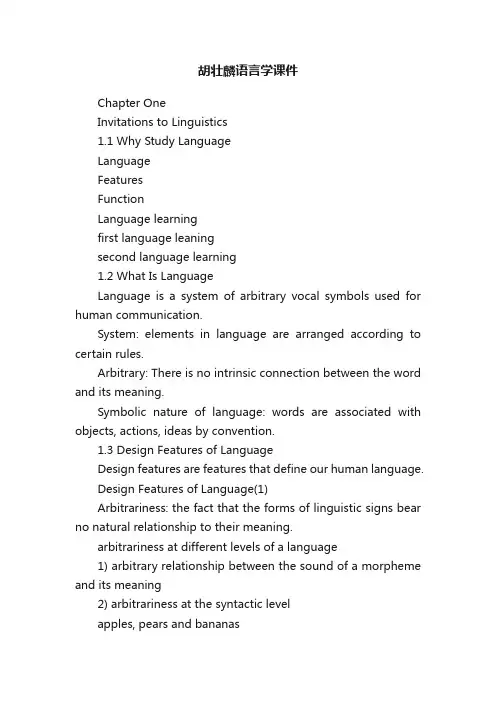
胡壮麟语言学课件Chapter OneInvitations to Linguistics1.1 Why Study LanguageLanguageFeaturesFunctionLanguage learningfirst language leaningsecond language learning1.2 What Is LanguageLanguage is a system of arbitrary vocal symbols used for human communication.System: elements in language are arranged according to certain rules.Arbitrary: There is no intrinsic connection between the word and its meaning.Symbolic nature of language: words are associated with objects, actions, ideas by convention.1.3 Design Features of LanguageDesign features are features that define our human language.Design Features of Language(1)Arbitrariness: the fact that the forms of linguistic signs bear no natural relationship to their meaning.arbitrariness at different levels of a language1) arbitrary relationship between the sound of a morpheme and its meaning2) arbitrariness at the syntactic levelapples, pears and bananaspears, apples and bananasb) He came in and sat down.He sat down and came in.He sat down after he came in.c) She got married and had a baby.She had a baby and got married.d) 屡战屡败屡败屡战3) arbitrariness and conventionarbitrariness→ language creativeconvention→ learnabili ty;→ learning a language laborious1.3 Design Features of Language(2)Duality: the property of having two levels of structures1) sound— secondary units2) meaning — primary units1.3 Design Features of Language(3)Creativity(productivity): Users can understand and produce sentences they have never heard before.1) Words can be used in new ways to mean new things.mouse bridge2) Its potential to create endless sentences by recursiveness (递归性)e.g. a. Smith believes that the earth is flatb. Brown believes that Smith believes that the earth is flatc. Smith believes that Brown believes that Smith believes that the earth is flatd. Brown believes Smith believes that Brown believes thatSmith believes that the earth is flat山里有座庙,庙里有个和尚,老和尚在念经,念的什么经:山里有座庙,庙里有个和尚,老和尚在念经,念的什么经:山里有座庙,庙里有个和尚,老和尚在念经,念的什么经……1.3 Design Features of Language(4)Displacement means that human languages enable their users to symbolize objects, events and concepts which are not present (in time or space) at the moment of communication.1.3 Design Features of Language(5)Cultural transmission: language is passed on through teaching and learning, rather than by instinct.1.4 Origin of LanguageThe bow-wow theory汪汪理论: imitate the sounds of the animals. onomatopoeicThe pooh-pooh theory噗噗理论: instinctive sounds of pain, anger and joy. interjectionThe yo-he-ho theory哟嗬哟理论: rhythmic grunts produced when working . chantsOrigin of LanguageThe divine-origin theory“So he (God) took some soil from the ground and formed all the animals and all the birds. Then he brought them to the man to see what he would name them, and that is how they got their names. So the man named all the birds and the animals,…”(Genesis,Chapter11:6)The invention theorya. imitativeb. cries of naturec. grunts of men working togetherThe evolution theory1.5 Functions of Language(1)Jakobson"Linguistics and Poetics: Closing Statement"All acts of communication, be they written or oral, are contingent on six constituent elements: context, message, addresser, addressee, contact and codeEach of the constituent elements of the communicative act has a corresponding function; thus:referential,poetic,emotive,phatic, conative and metalingualcontextREFERENTIALAddresser message addresseeEMOTIVE POETIC CONA TIVEcontactPHA TICcodeMETALINGUALReferential : to convey message and informationEmotive: to express attitudes, feelings and emotionsPoetic: to indulge in language for its own sakeConative: to persuade and influence others through commands and requestsPhatic: to establish communion with othersMetalingual: to clear up intentions and meanings1.5 Functions of Language(2)Halliday: three metafunctions of language:1) ide ational function is to organize the speaker’s or the writer’s experience of the real or imaginary world, i. e. language refers to real or imagined persons,things actions,events,states,etc.达意功能指组织说话者或作者现实或虚构世界的体验,即语言指称实际或虚构的人、物、动作、事件、状态等。
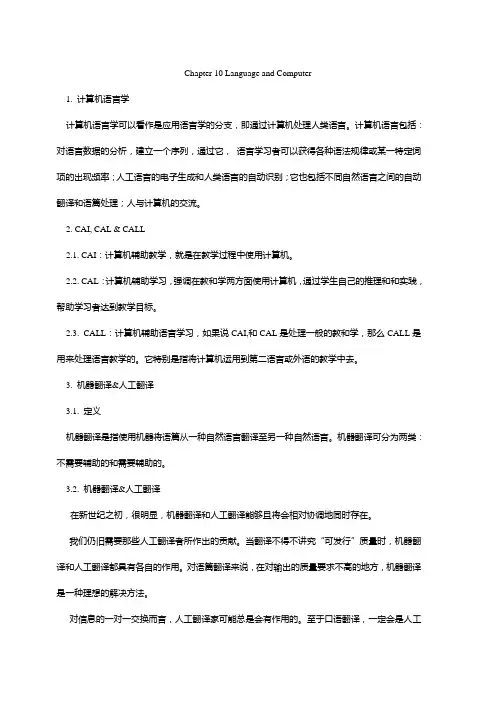
Chapter 10 Language and Computer1. 计算机语言学计算机语言学可以看作是应用语言学的分支,即通过计算机处理人类语言。
计算机语言包括:对语言数据的分析,建立一个序列,通过它,语言学习者可以获得各种语法规律或某一特定词项的出现频率;人工语言的电子生成和人类语言的自动识别;它也包括不同自然语言之间的自动翻译和语篇处理;人与计算机的交流。
2. CAI, CAL & CALL2.1. CAI:计算机辅助教学,就是在教学过程中使用计算机。
2.2. CAL:计算机辅助学习,强调在教和学两方面使用计算机,通过学生自己的推理和和实践,帮助学习者达到教学目标。
2.3. CALL:计算机辅助语言学习,如果说CAI,和CAL是处理一般的教和学,那么CALL是用来处理语言教学的。
它特别是指将计算机运用到第二语言或外语的教学中去。
3. 机器翻译&人工翻译3.1. 定义机器翻译是指使用机器将语篇从一种自然语言翻译至另一种自然语言。
机器翻译可分为两类:不需要辅助的和需要辅助的。
3.2. 机器翻译&人工翻译在新世纪之初,很明显,机器翻译和人工翻译能够且将会相对协调地同时存在。
我们仍旧需要那些人工翻译者所作出的贡献。
当翻译不得不讲究“可发行”质量时,机器翻译和人工翻译都具有各自的作用。
对语篇翻译来说,在对输出的质量要求不高的地方,机器翻译是一种理想的解决方法。
对信息的一对一交换而言,人工翻译家可能总是会有作用的。
至于口语翻译,一定会是人工翻译者的市场。
4. 计算机语料库4.1. 语料库(corpus)A collection of linguistic data, either compiled as written texts or as a transcription of recorded speech. The main purpose of a corpus is to verify a hypothesis about language--- for example, to determine how the application of a particular sound, word, or syntactic construction varies.语料库是一个语言数据的集合,可以有书面文本构成,也可以由录音言语的转写本构成。
胡壮麟语言学课件chapter12(名牌大学教授整理)胡壮麟语言学课件chapter11-名牌大学教授整理胡壮麟语言学chapter10(名牌大学教授整理)胡壮麟语言学第九章课件-名牌大学教授整理胡壮麟语言学第八章课件(名牌大学教授整理)胡壮麟语言学第六章课件(名牌大学教授整理)胡壮麟语言学第五章课件(名牌大学教授整理)胡壮麟语言学第四章课件(名牌大学教授整理)胡壮麟语言学第三章课件(名牌大学教授整理)胡壮麟英语语言学教学笔记Chapter 2 (名牌大学语言学教授整理)胡壮麟语言学教程第一章课件,名牌大学英语专业课课件,概括很全面,很到位哦胡壮麟语言学分章练习课件-chapter 12(名牌大学教授整理)胡壮麟语言学分章练习课件-chapter 8(名牌大学教授整理)胡壮麟语言学分章练习课件-chapter 7(名牌大学教授整理)胡壮麟语言学分章练习课件-chapter 6(名牌大学教授整理)胡壮麟语言学分章练习课件-chapter 5(名牌大学教授整理)胡壮麟语言学分章练习课件-chapter 4(名牌大学教授整理)胡壮麟语言学分章练习课件-chapter 2(名牌大学教授整理)胡壮麟语言学分章练习课件-chapter 1(名牌大学教授整理)大家论坛--英语专业考研--资料汇总--希望能对您的英语学习有帮助!!!鲜花送人,留己余香。
如果您觉得资料好,请您转发给需要的人——英语专业考研者没时间找资料的同学和朋友。
英语专业在校大学生希望获得本专业信息的人。
谢谢您!如有打扰,请包涵!更多考试经验的帖子在:大家论坛-英语专业考研版/forum-406-1.htmlQQ群大家论坛英语专业考研:221970617 ,欢迎您的加入。
高级英语第二册教材及教师用书第一册rar下载孙亦丽--大学英语精读学习精要--第一册第二册第三册pdf 下载孙辉的简明法语教程练习参考答案rar《480个最有用的法语动词》09年出版pdf下载大家论坛大学俄语阅读高分突破与技巧pdf 2005年版大家网《俄语语义:句法集成描写模式》下载【大家论坛】大学德语4(修订版)pdf--2003年版高教出版社张书良【大家论坛】传播学原理2009年版张国良《英语语言学基础》学习指南-南温洪瑞主编1999年08月版pdf基础英语真题:(北外)00-09年基础英语试题及答案详解大家论坛-英语专业考研版-真题+资料汇总/forum-406-1.html(华东师大)06年华东师大基础英语(华东师大)基础英语08-09年真题(华东师大)2007年“基础英语” 和“翻译”(华东师大)2008年“基础英语”和“翻译”(华东师大)03年基础英语(四川外语学院)09年基础英语真题(西外) 04年基础英语真题(川外) 05年基础英语真题(广外)历年基础英语考试真题(考研真题)天外07年基础英语节选(对外经贸大学)基础英语02-07年真题(对外经贸大学)09、10年基础英语考研真题(对外经贸大学)2001基础英语考研试题.pdf(南京师大)基础英语2004(南京师大)基础英语2003(南京师大)基础英语2001(大连海事大学)基础英语08-09年真题(山东师范大学)基础英语06-09年真题(外交学院)02-04年基础英语真题(华中师大) 07年基础英语真题(考研真题) 08 年中大基础英语(考研真题)09年中大基础英语(武大)2007基础英语(武大)2006基础英语法语真题:(北外)1998-2009年法语二外真题(北外)2002~2009北外法语二外真题答案)(北外)08年二外法语(北师)04年法语二外考研真题(上外)07年二外法语试题(上外)二外法语05-07年真题及答案(上外) 09 二外法语考研真题(对外经贸)09年二外法语试题(华东师大)08-09年法语二外真题(华东师大)2007年二外法语(华东师大)03-04年二外法语大家论坛-英语专业考研版-真题+资料汇总/forum-406-1.html(人民大学)02-07年法语二外真题(武汉大学)02-04年二外法语真题(大连外国语学院)2003年二外法语试题日语真题:(上海外国语大学)二外日语历年真题(北外)二外日语真题及丰富的资料!(中南大学)2006-2007年日语二外真题(南京师大)日语二外 2004(南京师大)日语二外 2001德语真题:(广外)二外德语真题(厦大)英专考研德语(二外)真题参考答案(厦大)英语专业考研德语(二外)真题北外西班牙真题:(北外)2001到2007 年西班牙语考试真题(山东师范大学)06-09年二外法语+二外日语(武汉大学)08年二外日语+法语真题(对外经贸)商英+笔译+口译+二外俄语翻译真题:(广外)英语专业历年初试真题水平+翻译与写作(武汉大学)2009综合英语汉译英真题及参考答案(南京大学)2007基础英语汉译英及参考答案文本及pdf (广外)10年写作与翻译真题(上外)01-08年英汉互译真题(外交学院)翻译真题及答案语言学方面真题:(中南大学)2006年英语语言文学与文化综合知识真题(四川外语学院)01-06年英语语言文学真题(长安大学)2007年英语语言学真题(四川外国语大学)英语专业2006年考研真题英美文学真题:(上海交通大学)07年英美文学考研真题(深圳大学)05年英美文学真题================================================= 语言学资料:英语修辞手法经济学人文本大家论坛-英语专业考研版-真题+资料汇总/forum-406-1.html英语语言学资料《英语语言学基础》学习指南-南温洪瑞主编1999年08月版pdf (华中师范大学)语言学课本教程2010版戴伟栋语言学笔记liguistics--胡壮麟超赞的笔记英美文学资料:高教版《英美文学选读》课文译文《英国文学简史》中文版英国文学主要作家作品汇总《英美文学史》之英国文学作家作品大全《美国文学简史》(上)中文版英国文学史考试要点英美文学部分作家的介绍和评论外国文学史图表版笔记整理英国文学部分作品分析英美文学超全题库十套考研英美概况练习题(含答案)翻译资料:汉语成语典故谚语与歇后语英语翻译全国68所院校英汉互译试题分析英语专业考研翻译超全面的笔记~英语专业考研各大院校题型对比分析pdf法语真题回忆版:(北师)2010年二外法语真题回忆版(广外)10年二外法语试题回忆(北京师范大学)2010年二外法语真题回忆版(南京师大) 09外院二外法语回忆大学法语简明教程笔记汇总记忆法语名词阴阳性的方法法语重要句型汇总实用法语语法 - 精讲与练习(中国宇航出版社)日语学习资料:日本语表现文型辞典(最全最实用的句型大全)日语语法及词汇练习题1500题标准日本语法笔记资料考研日语(非日语专业)资料大家论坛-英语专业考研版-真题+资料汇总/forum-406-1.html日语二外考研作文18篇93年到07年的全国日语考试日语二外需掌握的最基本词汇大家论坛-英语专业考研版-真题+资料汇总/forum-406-1.html。